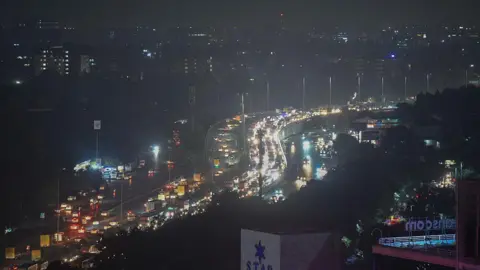Thousands of commuters in one of India's wealthiest suburbs were stuck on roads for six to eight hours due to rain-triggered traffic gridlock on Monday.
The incident has sparked outrage online, with many questioning how a place like Gurugram - known for its futuristic skyscrapers and sprawling corporate offices - could have such poor infrastructure.
Disaster management authorities in the suburb, which is located on the outskirts of capital Delhi, have advised offices, schools, and colleges to work from home on Tuesday as more rainfall is predicted.
Torrential rains have wreaked havoc in several parts of India this year, killing hundreds of people in floods and landslides.
Many people took to social media to express their frustration with Gurugram's nightmarish traffic, which was more than 10km (6.2 miles) long on one road, according to local media.
A viral video shows a never-ending row of cars clogging at least a dozen lanes of a key highway.
Gurugram is drowning. You pay exorbitant rent to come home to this, one user said on X.
Frustrated residents raised questions about why the state has not been able to improve infrastructure in the city, which houses the regional headquarters of some of the biggest companies, including Google, Meta, American Express and Samsung.
Meanwhile, weather warnings have been issued in Delhi and surrounding cities. The Yamuna river, which passes through the city, has crossed the danger mark over the past few days, flooding some low-lying areas. Authorities have been urging people living there to move to safer places.
In a social media post on Monday, Delhi Chief Minister Rekha Gupta assured residents that the situation was being closely monitored.
India regularly witnesses severe floods during the monsoon season, which runs between June and September. But officials say the intensity of rains this season has been significantly higher, with severe impacts felt across multiple states.
The recent flooding events have been deadly, with significant casualties reported in states like Punjab and Himachal Pradesh. As India grapples with the effects of climate change, the risks associated with monsoon seasons are becoming increasingly apparent.





















